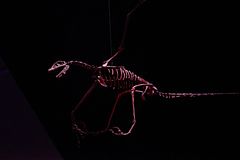| Rahonavis Temporal range: Late Cretaceous (Maastrichtian)
| |
|---|---|

| |
| Reconstructed skeleton, Royal Ontario Museum | |
| Scientific classification | |
| Domain: | Eukaryota |
| Kingdom: | Animalia |
| Phylum: | Chordata |
| Clade: | Dinosauria |
| Clade: | Saurischia |
| Clade: | Theropoda |
| Clade: | Paraves |
| Genus: | †Rahonavis Forster et al., 1998b |
| Type species | |
| †Rahonavis ostromi | |
| Synonyms | |
| |
Rahonavis is a genus of bird-like theropod from the Late Cretaceous (Maastrichtian, from about 72.1 to 66 mya) of what is now northwestern Madagascar. It is known from a partial skeleton (UA 8656) found by Catherine Forster and colleagues in Maevarano Formation rocks at a quarry near Berivotra, Mahajanga Province.[1] Rahonavis was a small predator, at about 70 centimetres (2.3 ft) long and 0.45-2.27 kg (1-5 lbs),[2] with the typical dromaesaurid-like raised sickle claw on the second toe. It was originally the first African coelurosaur until the discovery of Nqwebasaurus in 2000.[3]
The name Rahonavis means, approximately, "cloud menace bird", from Malagasy rahona (RA-hoo-na, "cloud" or "menace") + Latin avis "bird". The specific name, R. ostromi, was coined in honor of John Ostrom.
- ^ Tudge, Colin (2009) The Bird:A Natural History of Who Birds Are, Where They Came From, and How They Live [1]
- ^ Holtz, Thomas R. Jr. (2008) Dinosaurs: The Most Complete, Up-to-Date Encyclopedia for Dinosaur Lovers of All Ages Supplementary Information
- ^ De Klerk, William; Forster, Catherine; Sampson, Scott; Chinsamy-Turan, Anusuya; Ross, Callum (2000-06-27). "A new coelurosaurian dinosaur from the Early Cretaceous of South Africa". Journal of Vertebrate Paleontology. 20 (2): 324–332. doi:10.1671/0272-4634(2000)020[0324:ANCDFT]2.0.CO;2.